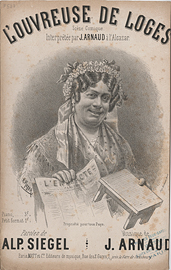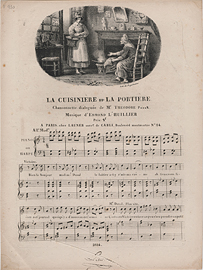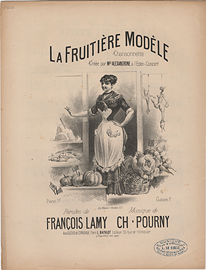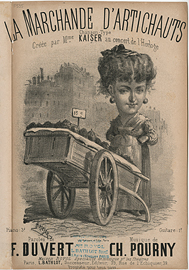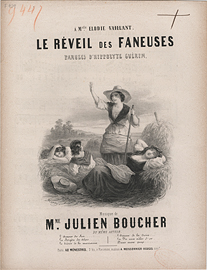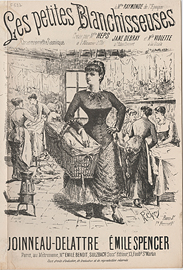There were fishmongers; the elder was superb. The young one, who sold freshwater fish, resembled a virgin in a Murillo painting, all blonde in the midst of her carps and eel.
– Émile Zola, Le ventre de Paris (1873, I, 27).
The woman worker [l’ouvrière]! … this word sounds to the ears like a synonym for, or like a summary of cruel things: pain, privation, misery, prostitution.
– Hippolyte Dussard, Le Journal des économistes (1861, 84).
The multitude of female workers depicted in song challenges the narrative that women were long excluded from the workforce. The cover illustrations and titles in the 19th-Century French Sheet Music Collection reveal that women performed a surprising variety of jobs, including porteuses d’eau (water carriers), bonnes (domestic servants), nourrices (wet nurses), lingères (linen maids), tailleuses (tailors), couturières (dressmakers), fileuses (spinners), cuisinières (cooks), and portières (concierges). Indeed prior to the 1860s, women made up approximately one third of the workforce and were employed primarily in the clothing and textile industries, domestic service, and agriculture.
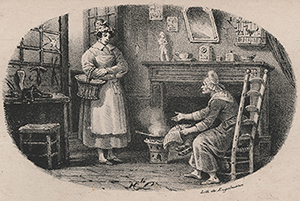 La cuisinière et la portièreThese examples of women working also problematize the idea that women were largely relegated to the private sphere. According to Joan Scott and Louise Tilly (1975), the belief that woman’s place was in the home, away from the public realm, was a nineteenth-century invention that served to promulgate bourgeois values. While bourgeois women gradually joined the workforce, working-class urban and rural peasant women had long participated in it—and often out of necessity. Thus working was not a universal female experience, nor did it have the same emancipatory associations for all women.
La cuisinière et la portièreThese examples of women working also problematize the idea that women were largely relegated to the private sphere. According to Joan Scott and Louise Tilly (1975), the belief that woman’s place was in the home, away from the public realm, was a nineteenth-century invention that served to promulgate bourgeois values. While bourgeois women gradually joined the workforce, working-class urban and rural peasant women had long participated in it—and often out of necessity. Thus working was not a universal female experience, nor did it have the same emancipatory associations for all women.
Urban centers in particular witnessed an increasingly visible number of women in the workforce, in part due to migration from rural regions. Urban occupations ranged from the blanchisseuse (laundress) to the marchande (street seller). To catchy, short melodic calls, many of which are preserved in transcriptions (for example in Georges Kastner’s Les voix de Paris, 1857), women would advertise their goods for sale: leeks, herring, old shoes, artichokes, flowers. The theatre industry was another sector that employed women. In addition to appearing as singers and actresses, women worked as souffleuses (prompters) and ouvreuses de loges (ushers) in theatres and opera houses.

